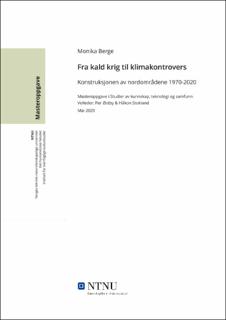| dc.contributor.advisor | Østby, Per | |
| dc.contributor.advisor | Stokland, Håkon | |
| dc.contributor.author | Berge, Monika | |
| dc.date.accessioned | 2021-09-24T18:30:32Z | |
| dc.date.available | 2021-09-24T18:30:32Z | |
| dc.date.issued | 2020 | |
| dc.identifier | no.ntnu:inspera:55926857:25354293 | |
| dc.identifier.uri | https://hdl.handle.net/11250/2781813 | |
| dc.description.abstract | Begrepet nordområdene ble introdusert på 1970-tallet. Siden har nordområdene vært involvert i en omfattende konstruksjonsprosess som gradvis har endret begrepets innhold og betydning. Nordområdene har gått fra å være forbundet med kald krig og sikkerhetspolitikk til å i dag være forbundet med klima- og miljøhensyn. Jeg ønsker i denne avhandlingen ved å studere nordområdene, å vise hvordan det har utviklet seg som begrep og politikk. Oppgavens problemstilling er: Hvordan har nordområdene blitt konstruert som begrep og styringsobjekt, og hvordan har det endret seg i årene mellom 1970 og 2020? Oppgaven anvender teorier fra STS-feltet; innrammingsperspektivet, grenseobjekt og styringsteknologi, og identifiserer tre faser i nordområdenes konstruksjon og utvikling: Fase 1 var 1970-1990, fase 2 var 1990-2010 og fase 3 tar for seg perioden 2010 til 2020.
Da begrepet først ble tatt i bruk på 1970-tallet var det kald krig og det anspente forholdet til Sovjetunionen begrepet assosierte til. Det ble gjort flere forsøk på å samarbeide gjennom havrettsdiskusjonene og delelinjeforhandlingene. Mikhail Gorbatsjovs tale i Murmansk i 1987, endret den sikkerhetspolitiske atmosfæren og etter 1990 ble samarbeid nøkkelordet for innrammingen. Samarbeid med Russland var avgjørende for Norge, hvor atomsikkerhet, miljøvern og petroleum, var viktige samarbeidsområder. Samarbeidsflatene skapte en felles kommunikasjon og forståelse om hva nordområdene var. Norske myndigheter lanserte fra 2000-tallet flere styringsdokumenter som styrket innrammingen. Etter 2010 fikk hensynet til klimaendringene stadig mer plass i området. Nordområdepolitikken måtte nå holde både petroleumsinteresser og klimahensyn sammen. Den nye innrammingen holder både næringsutvikling og klimatiltak innenfor rammen. Oppgaven diskuterer også bruken av de to begrepene grenseobjekt og politisk teknologi og om disse kan forklare sider av den beskrevne utviklingen.
Gjennom dette har oppgaven vist at nordområdene, side begrepet ble introdusert på 1970-tallet har vært gjenstand for varierende innhold og ulike betydninger. Begrepet har gått fra å assosiere til sikkerhetspolitiske konflikter, til samarbeid, næringsvirksomhet og klimatiske utfordringer. Disse forandringene har skjedd som følge av hvordan området har blitt rammet inn av ulike aktører på ulike tidspunkt i konstruksjonen. | |
| dc.description.abstract | The term the High North was introduced in the 1970s. Since then the High North has been involved in an extensive construction process that gradually has changed the terms’ content and meaning. The High North has gone from being linked to cold war and security policy, to today being linked to climate and environmental considerations. In this thesis, by studying the High North, I want to show how it has evolved as a concept and policy. The thesis’ question is: How has the High North been constructed as a term and a management object, and how it has changed in the years between 1970 and 2020? This thesis applies theories from the STS-field: the concept of framing, border objects, and governmental technologies, and identifies three phases in the High North’s construction and development: Phase 1 was 1970-1990, phase 2 was 1990-2010 and phase 3 spans the period 2010 to 2020.
When the term was first used in the 1970s, it was the Cold War and the tense relationship with the Soviet Union the term associated with. Several attempts were made to collaborate through the Law of the Sea and the diving line negotiations. Mikhail Gorbatsjovs speech in Murmansk in 1987, changed the security policy atmosphere and after 1990 collaboration became the key word for the frame. Collaboration with Russia was crucial for Norway, where nuclear security, environmental protection and petroleum were important areas of collaboration. The collaborative areas created a common communication and understanding of what the High North was. Norwegian authorities launched several policy documents from the 2000s, that strengthened the framing. The new framing keeps both industrial development and climate change measures within the frame. This thesis also discusses the use of the two terms border objects and governmental technologies and if these can explain aspects of the described development.
Through this, the thesis has shown that the High North, since the term was introduced in the 1970s, has been subject to varying content and different meanings. The term has gone from associating to security policy conflict, to collaboration, industrial activities, and climate challenges. These changes have occurred as a result of how the area has been framed by different actors at different times in the construction.
| |
| dc.language | nob | |
| dc.publisher | NTNU | |
| dc.title | Fra kald krig til klimakontrovers: Konstruksjonen av nordområdene 1970-2020 | |
| dc.type | Master thesis | |
